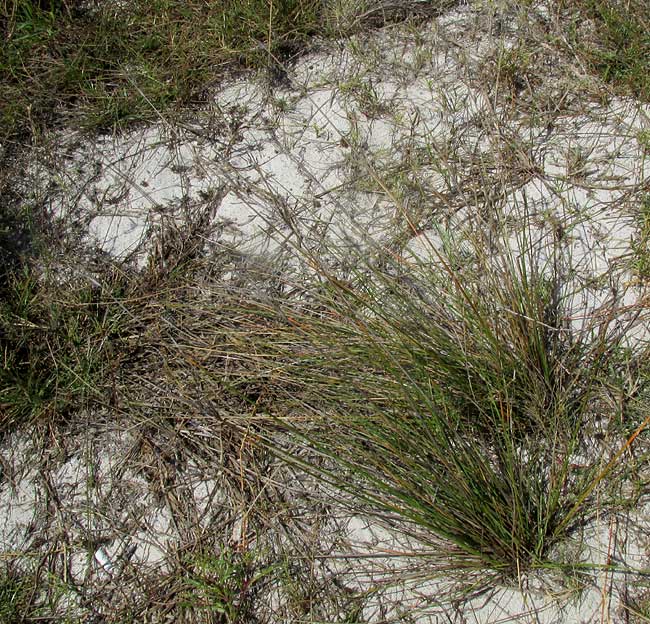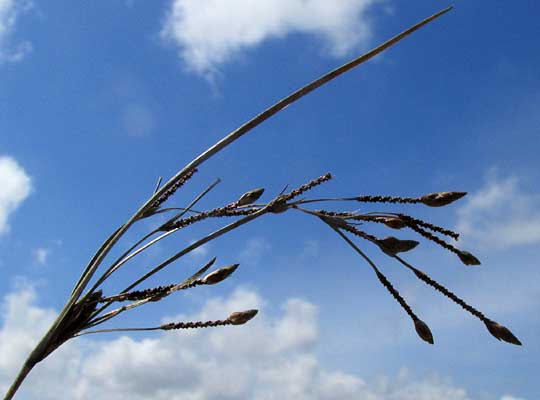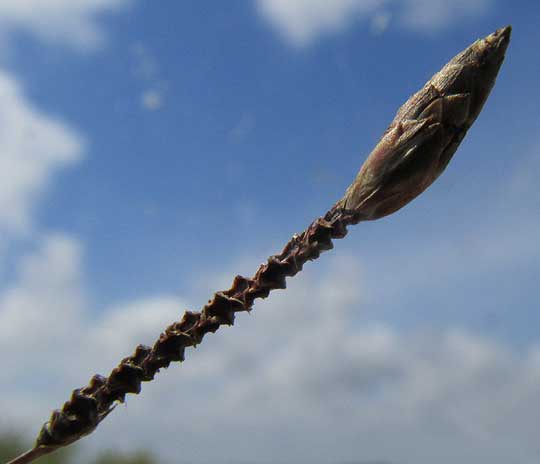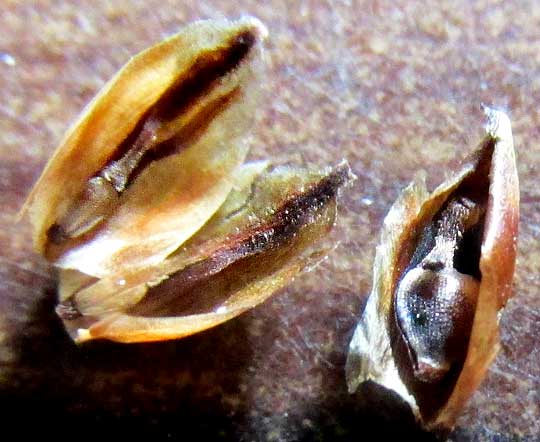Excerpts from Jim Conrad's
Naturalist Newsletter

from the April 5, 2015 Newsletter issued from Río Lagartos, on the Yucatan Peninsula's northern coast (~N21.60°, ~W88.16°), Yucatán state, MÉXICO
CHESTNUT SEDGE
On the sandy, salt-saturated, wind-swept, sun-baked banks of the canal cutting through the slender finger of land separating Ría Lagartos Estuary from the Gulf of Mexico, one of the most common plants is a knee-high, perennial, grass-like species presenting itself as dense tufts of stiff, straight, tough, almost needle-like, sharp-pointed blades, as shown above.
The plant is so plain looking that at first glance it offers the esthetic impact of dead grass in an abandoned city lot. However, if you look closely, interesting details emerge. For one thing, not all the slender items in the tufts are needle-like blades. At this season most tufts include at least one stiff, cylindrical stem topped with clusters of old flowering heads, or inflorescences, as shown below:

The inflorescences are long past their flowering stage, as can be seen better below:

That picture shows an old flowering spike consisting of the spike's axis, or "rachis," from which most of its dry, one-seeded, achene-type fruits with their subtending scale-like bracts already have fallen off, leaving the rachis interestingly scarred in a zigzag fashion. At the rachis's tip, a few bracts still wrap themselves around achenes. If you carefully remove lower scales from these rachis-tip bunches, you find them wrapped around flattish, dark-brown achenes ornamented with many vertical lines of microscopic pits, as shown below:

Notice that the flowers are arranged spirally on the rachis causing the spike to be round in cross-section; they're not in pairs opposite one another causing the spike to be flat. In short, this plant is not a grass -- not a member of the Grass Family, the Poaceae -- whose spikelets are nearly always flat or flattish.
These plants are members of the big Sedge Family, the Cyperaceae. We've encountered a plant with very similar basic structure, in sand of a salty coastal lagoon on the Yucatan Peninsula's Caribbean coast. That was Hurricane-grass, Fimbristylis cymosa, profiled at www.backyardnature.net/yucatan/fimbry.htm.
Our present plants also are members of the genus Fimbristylis. They're FIMBRISTYLIS SPADICEA, sometimes known as Chestnut Sedge or Marsh Fimbry, the first name remarking on the presence of dark chestnut color on the achenes, bracts and often the blades. Chestnut Sedge occurs in sandy, salty marsh environments from southern Mexico to northern South America.
Six species of Fimbristyles occur in the Yucatan. Besides its chestnut blotching, Chestnut Sedge's open flowering head -- its spikes being on fairly long stems -- distinguish it from the other species.
Ecologically, Chestnut Sedge's roots and tough tufts of blades protect sandy, loosely consolidated land from erosion, plus you can imagine that its tiny achenes make fine nibbling for small, seed-eating birds such as sparrows and finches.